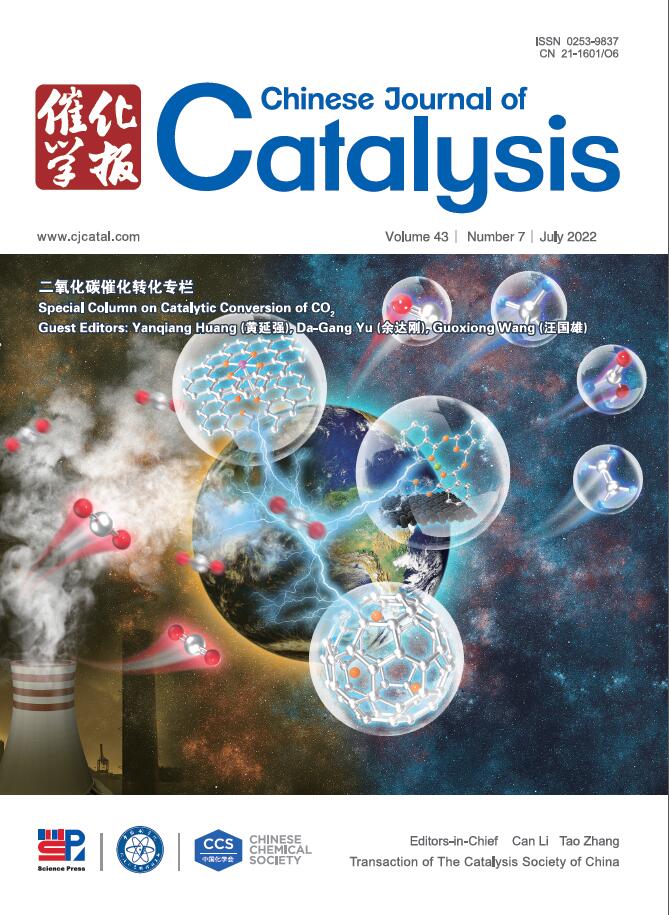CO2加氢诱导过程中In2O3催化剂结构演变的实验与计算研究
IF 17.7
1区 化学
Q1 CHEMISTRY, APPLIED
引用次数: 0
摘要
甲醇合成是一种重要的工业上可行的二氧化碳利用方法,是生产绿色燃料和商品化学品的平台。对于可持续的甲醇合成,In2O3是一种理想的催化剂,已经引起了极大的关注。本文通过沉淀法制备了立方In2O3纳米颗粒,并对CO2加氢制备甲醇进行了评价。在反应开始的10 h内,CO2转化率逐渐升高,同时甲醇选择性缓慢下降,10-20 h后反应达到平衡。这个激活和诱导阶段可能归因于In2O3纳米颗粒的烧结和在In2O3表面产生更多的氧空位。进一步的实验研究表明,氢诱导在催化剂活化阶段产生额外的氧空位,提高了In2O3催化剂的CO2加氢性能。密度泛函理论计算和微动力学模拟进一步表明,在诱导期形成的氧空位覆盖率较高的表面或羟基化表面可以提高反应速率,提高CO2转化率。然而,它们主要促进CO而不是甲醇的形成,导致甲醇选择性降低。这些预测与上述实验观察结果很吻合。因此,我们的工作为In2O3纳米催化剂上CO2加氢过程的诱导阶段提供了深入的分析,并为显著提高In2O3基催化剂的CO2反应活性同时保持长期稳定性提供了有价值的见解。本文章由计算机程序翻译,如有差异,请以英文原文为准。
An experimental and computational investigation on structural evolution of the In2O3 catalyst during the induction period of CO2 hydrogenation
As one of the most important industrially viable methods for carbon dioxide (CO2) utilization, methanol synthesis serves as a platform for production of green fuels and commodity chemicals. For sustainable methanol synthesis, In2O3 is an ideal catalyst and has garnered significant attention. Herein, cubic In2O3 nanoparticles were prepared via the precipitation method and evaluated for CO2 hydrogenation to produce methanol. During the initial 10 h of reaction, CO2 conversion gradually increased, accompanied by a slow decrease of methanol selectivity, and the reaction reached equilibrium after 10-20 h on stream. This activation and induction stage may be attributed to the sintering of In2O3 nanoparticles and the creation of more oxygen vacancies on In2O3 surfaces. Further experimental studies demonstrate that hydrogen induction created additional oxygen vacancies during the catalyst activation stage, enhancing the performance of In2O3 catalyst for CO2 hydrogenation. Density functional theory calculations and microkinetic simulations further demonstrated that surfaces with higher oxygen vacancy coverages or hydroxylated surfaces formed during this induction period can enhance the reaction rate and increase the CO2 conversion. However, they predominantly promote the formation of CO instead of methanol, leading to reduced methanol selectivity. These predictions align well with the above-mentioned experimental observations. Our work thus provides an in-depth analysis of the induction stage of the CO2 hydrogenation process on In2O3 nano-catalyst, and offers valuable insights for significantly improving the CO2 reactivity of In2O3-based catalysts while maintaining long-term stability.
求助全文
通过发布文献求助,成功后即可免费获取论文全文。
去求助
来源期刊

Chinese Journal of Catalysis
工程技术-工程:化工
CiteScore
25.80
自引率
10.30%
发文量
235
审稿时长
1.2 months
期刊介绍:
The journal covers a broad scope, encompassing new trends in catalysis for applications in energy production, environmental protection, and the preparation of materials, petroleum chemicals, and fine chemicals. It explores the scientific foundation for preparing and activating catalysts of commercial interest, emphasizing representative models.The focus includes spectroscopic methods for structural characterization, especially in situ techniques, as well as new theoretical methods with practical impact in catalysis and catalytic reactions.The journal delves into the relationship between homogeneous and heterogeneous catalysis and includes theoretical studies on the structure and reactivity of catalysts.Additionally, contributions on photocatalysis, biocatalysis, surface science, and catalysis-related chemical kinetics are welcomed.
 求助内容:
求助内容: 应助结果提醒方式:
应助结果提醒方式:


